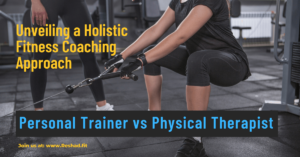After reading this post, you will receive answers to the following questions: What is corrective exercise? How does corrective exercise work? Why is corrective exercise important? What benefits exactly can be expected after receiving a precise corrective exercise programme? What are the major benefits? Who would benefit the most from a corrective exercise intervention? Who can offer you corrective exercises? And so many other things.
What is corrective exercise?
A corrective exercise involves performing specific physical movements to address and resolve issues related to body movement. These issues may or may not be accompanied by pain. However, any movement that deviates from the normal range for an individual’s body structure can lead to additional restrictions in movement and potential pain if left unattended.
However, in certain cases, particularly with chronic conditions, corrective exercises alone may not suffice to fully resolve movement impairments and alleviate pain. In order to effectively address movement dysfunction, it is crucial to employ clear, simple, accurate, and appropriate corrective strategies and interventions, with corrective exercises being one component of this approach. This is because, aside from factors like nutrition and recovery, psychological issues can also contribute significantly to major movement problems. Therefore, a comprehensive corrective strategy is necessary for the long-term resolution of movement issues.
How does corrective exercise work?
Movement is the culmination of intention and an intricate network of communications within the body. Among various systems, three primary systems play a crucial role in shaping movement patterns: the nervous system, the skeletal system, and the muscular system (collectively known as the neuromusculoskeletal system). Any dysfunction within these systems can lead to a range of problems, such as pain, other movement impairments, weakness, a lack of balance, a lack of mobility, and asymmetry, among others.
Once a movement limitation is identified, a corrective exercise is implemented to address the issue. In essence, exercise can help restore optimal performance to a specific body part or parts by addressing factors such as limited mobility, weakness, and impaired motor control (the nervous system’s control over a body part). However, as mentioned earlier, psychological issues or dysfunctions in the fascia and neuromusculoskeletal system can also contribute to problems. Addressing a movement issue requires a multifaceted approach. Nevertheless, once the problem is accurately identified, which can be challenging for many, resolving it becomes manageable.
In summary, a physical corrective movement practitioner possesses an understanding of several key aspects:
- The mechanics behind the process of movement
- The unique and ideal movement patterns for each individual, recognising that they can vary from person to person at some points.
- The factors contributing to the development of movement limitations
- The potential causes that can lead to movement limitations
- The appropriate corrective interventions are needed to address and resolve these limitations.
- The creativity and implementation of corrective exercise and knowledge of exercise physiology
Why is corrective exercise important?
Many people nowadays lead more sedentary lives, which increases the risk of poor health. On the other hand, the majority of people are doing things that encourage poor posture, which makes inactivity worse.
Take, for instance, the average weight of the human head, which amounts to around 12 pounds. The soft tissues in the neck are naturally adept at stabilising and distributing this weight effectively when positioned directly above the shoulders, adhering to what we consider the “ideal” posture. However, for every inch the head tilts forward, the supporting muscles must contend with an additional burden of approximately 10 pounds. When the head is inclined at a 45-degree angle, as is common while texting or working on a laptop, the strain on the neck can surge to a staggering 42 pounds. This not only places excessive stress on the neck muscles but also diminishes lung capacity by up to 30%.
At the same time, there has been a noticeable surge in the number of individuals embracing high-intensity workouts. These can range from individual workouts such as weight lifting to intense preparations for events like marathons, triathlons, or adventure races. Some people might even join group classes taught by instructors with little coaching and training experience. However, many individuals are ill-prepared for these demanding endeavours due to insufficient fitness levels, poor movement techniques, or inadequate guidance in exercises such as weight lifting.
To sum up, people are generally leading increasingly sedentary lifestyles, but when they do engage in physical activity, they often push themselves beyond their limits of strength, mobility, and motor control. This combination of extremes in the realm of fitness has led to a significant number of individuals experiencing movement and postural issues that were not as prevalent in previous centuries. Therefore, it is essential to incorporate corrective exercises and strategies as needed into the lifestyles and training routines of a large portion of the population today.
What are the major benefits?
With the prevalence of movement dysfunctions, muscle imbalances, and joint pain afflicting both active and sedentary populations, corrective exercise has become an essential tool for enhancing performance and promoting pain-free movement throughout one’s lifetime. When effective corrective interventions are used, there are three major health benefits.
Improving performance
People are not aware of their movement problems most of the time. Indeed, I’ve never seen anyone who doesn’t experience some kind of movement issue at times, even those who are considered experts in healthcare. This is because most people don’t know how to use their bodies in a functional and natural way. And over time, they adapt to the way they move their bodies. This type of movement that is not optimal can have many negative consequences in the long run. In fact, most chronic physical pain and movement problems are the result of such negligence in the past.
For instance, due to a lack of understanding of how the human body functions, most people, even at high levels of fitness, don’t exercise and train accurately. Their training plan always lacks better movement in terms of quality, quantity, functionality, fitness, anatomical plane, and so on. Over time, such a misunderstanding, which can be a kind of physical abuse of the body, results in movement asymetry and restriction in the body.
On the other hand, identifying these problems and applying accurate and corrective strategies to fix them can significantly improve one’s physical performance and fitness. In my view, it must be taught at school, and all of us should learn how to move well from childhood, not when we face a difficulty. Therefore, to live well and pain free, corrective strategies, which include corrective exercise, should be a part of your physical activity and training. They play a crucial role in enhancing your performance.
Restoring performance
Corrective exercises can restore one’s initial performance, which is not different from improving performance. Restoring physical performance can be achieved through corrective exercise for people who have physical limitations due to accident, injury, surgery, abnormal posture, acquired structural limitations, and abnormal movement patterns, to name a few.
Because of lack of awareness, or the so called body’s mechanism, for example, after an injury, our body, while healing, creates some movement and physical limitations too. And these movement limitations can become normal for most people over time. They live with such abnormalities. Unfortunately, most are not aware of such abnormalities, which were acquired over months or years. Most chronic pain, such as lower back pain and knee pain, is the result of them.
If these problems are identified at their root, corrective exercise can play a big role in overcoming these limitations. When limitations are fixed, performance is restored; in other words, performance is improved.
Preventing injury
Preventing injury is the same as restoring performance, which is the same as improving performance. All are the same. But to emphasise the benefits of exercise, and since for most, these three might be three different things, I have outlined the benefits into three sub titles.
Any kind of physical activity with movement limitations over time results in serious health conditions. It’s very clear. In other words, acute or chronic pain due to movement restriction is a sign of an injury in most cases. Indeed, a movement limitation is the first stage of an upcoming injury that may occur now or later if the limitation is not addressed. So fixing the problem or problems results in preventing an injury or injuries.
What outcomes or benefits exactly can be expected after receiving a precise corrective exercise programme?
Without a doubt, I can confidently state that a well-crafted corrective exercise programme produces positive outcomes. However, it’s important to note that these outcomes can vary from person to person depending on their physical capabilities, movement impairments, and attentiveness. In general, individuals who diligently follow a precise corrective exercise programme can anticipate experiencing the following outcomes:
Relaxation and efficiency of movements
Relaxation and efficiency of the movements are the major outcomes of corrective intervention. After completing a series of corrective exercises, for example, you can experience a sense of ease and lightness, which allows you to move with greater fluidity and ultimately enhances your performance. Whether engaging in activities such as walking, squatting, deadlifting, jogging, climbing, or even simply standing and sitting, relaxation and efficiency in movement eliminate or gradually diminish any pain you experience.
Good coordination
Remember that any movement you perform in daily life is a team game, and proper teamwork between the joints and muscles is more important than their individual performance. When an identified movement problem is fixed in the body, proper teamwork between each body part, muscle group, and joint naturally occurs; in other words, such proper teamwork is coordination. Good coordination and efficiency in the body happen when your entire body operates as one unified entity rather than being divided into isolated body parts, even in those so-called single joint movements.
Distribution of effort or force generation
In order to effectively manage the mechanical strain associated with movement and exercise, it is essential to distribute it across as many body parts as possible, much like teamwork. The more team members involved in performing the work of a movement or exercise, the more work can be done. This ultimately increases the amount of work and improves performance and injury-free movements.
While many people think exercises such as deadlifts or squats are physically demanding, this is not necessarily the case. By ensuring that your entire body functions cohesively as a unified block, these so-called demanding exercises can be quite enjoyable. In such circumstances, any form of movement can be pleasurable, as long as you refrain from pushing your body beyond its physical capabilities and fitness.
Division of labour
A key result of an effective corrective exercise programme is the restoration and enhancement of the body’s mechanical functionality. In other words, for example, muscles should perform the role to which they are best suited—stabilisers stabilise, prime movers move, large muscles create power, and smaller muscles direct forces.
Position and alignment
Achieving correct alignment and positioning of each body part in relation to one another yields beneficial outcomes for both performance and physical well-being. In simpler terms, joints, for instance, experience maximum safety and functionality when maintained in a neutral or centred position. Coordinated movement and effective transfer of load, generated force, or exertion from one body segment to another, ending in contact points like the ground, can only be mechanically efficient when joints are consistently centred and aligned.
Timing
Optimal timing in terms of muscle activation order can greatly enhance a movement pattern. It is crucial, for instance, that stabilising muscles be activated prior to prime movers. Functional movements like squats and deadlifts require correct sequencing. In these movements, which mimic everyday activities, muscles must first lengthen before shortening to take advantage of elastic recoil, the passive properties of the soft tissues, and reflexive muscle activation. These outcomes arise from a corrective exercise programme integrated with other corrective approaches.
Variability
Adapting movements to our body is different from adapting our body to specific movements. The former is ideal, while the latter is not. However, most people tend to follow specific movement patterns rather than variabilities in movements. Movement is like language, in which variability, not just precision, is what determines fluency. When variability in the human body’s movement is effortless and natural, the body can move more efficiently and effortlessly. Such variability in movements indicates that the body is optimised to move in various planes and angles and has sufficient levels of physical fitness.
Comfort
Movement communicates with you, particularly if you are interested in asking questions and paying careful attention to your body. Good movement is pain free, effortless, and natural. If you struggle to complete a physical task and feel discomfort, there is a high chance of an underlying issue. One of the primary outcomes of corrective exercise is the enhancement of comfort and ease in movements.
Who would benefit the most from a corrective exercise intervention?
As I pointed out, a well-designed corrective exercise intervention can benefit nearly everyone. However, certain individuals can derive even greater advantages. These individuals typically experience significant pain or discomfort when performing specific exercises or movements or have pain and stiffness the next morning. Such people fall into the following categories:
- Individuals who struggle to execute complex movements correctly, such as squats or deadlifts, due to limited mobility, stability, control, or psychological factors like fear
- Individuals who have recently undergone surgery or have a history of injuries
- Individuals experiencing chronic physical pain, including prevalent conditions like lower back pain, knee pain, or shoulder pain.
- Individuals who encounter pain or discomfort during certain movements, such as squatting and a shoulder press, or after prolonged periods of sitting or walking
- Individuals with postural abnormalities
By addressing these categories of individuals, a well-designed corrective exercise intervention can yield substantial benefits.
Who can offer you corrective exercises?
As I mentioned earlier, corrective exercise alone may not be sufficient to address movement dysfunctions. In essence, a comprehensive approach is required, wherein corrective exercise plays a vital role. Therefore, an individual who possesses a profound understanding of the body’s anatomy and physiology, particularly in relation to movement, as well as an awareness of how psychological factors can impact movement, exercise physiology, movement abnormalities, movement dysfunction, training programming, and creativity in exercise and drills, can offer optimal corrective exercise. This individual may be a passionate so-called physical therapist or fitness trainer who demonstrates a genuine interest in the overall well-being and health of individuals rather than solely focusing on a specific aspect.


